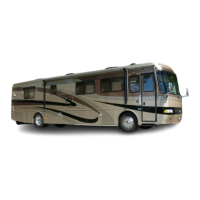The air braking system on the motorhome is equipped with several safety
features unlike that of automotive hydraulic braking systems. One safety fea-
ture is a low air pressure warning system. Should a low air condition arise
while the vehicle is under operation, a warning buzzer will sound and a dash
warning light will illuminate alerting the operator of the situation. This warn-
ing occurs at approximately 60-65 psi (pounds per square inch).
A simple mechanical explanation of what occurs when a brake application
is made is as follows: The air system supplies air to the foot brake, this is
called a treadle valve. Pushing down on the treadle valve supplies an air
charge signal to a brake chamber. This sealed chamber consists of a spring
and air bladder. The air charge signal pushes on the bladder which extends a
threaded rod connected to the automatic slack adjuster. The slack adjuster
rotates the S-cam expanding the shoes against the drum. Air disc brakes fol-
low much the same principal, with the exception of the S-cams.
The park and emergency brake systems are combined and apply to the
rear drive axle only. These are called spring brakes. When the park brake is
applied air is released from the rear brake chambers allowing the large spring
in each rear brake chamber to manually push against the automatic slack
adjuster. This rotates the S-cam applying the brake shoes against the drum.
The air system charged above 35 psi is approximately the point at which the
park brake will remain released. Pushing down on the park brake handle
charges the rear brake chambers with air pressure, overriding the emergency
brake springs and releasing the brakes. In the event of air loss while the vehi-
cle is under operation, the park brake will automatically apply, (this occurs at
approximately 30 psi) acting as an automatic emergency brake system.
When preparing to depart, allow the air system to achieve full air pres-
sure. This is indicated by the air gauge needles. Listen for the air dryer to
purge, indicating full air pressure has been obtained and air dryer is function-
ing. Look and listen for any abnormalities. Abnormal air pressure readings
by either needle of the air gauge should alert the operator. Have the air sys-
tem checked to avoid an untimely failure.
Should a failure occur in the air system, preventing the air pressure from
building, it may become necessary to “cage” the spring brakes. This is an
emergency procedure only. Caging the rear air brake chambers manually
overrides the spring brakes and allows the vehicle to move. This procedure
does not affect normal service braking. The brake disabling procedure is
located in Section 2.
NOTE When park brake is released park illumination lamp will
remain lit until air system pressure is above 65 psi.
Chassis Information
---------------------------------------------------------------------------------------------------------------------------------------------------------------------------------------------------------------------------------------------------------------------------------------------------------------------
WINDSOR
10•266
BRAKE PARK &
EMERGENCY
SYSTEMS

